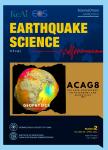版权所有:内蒙古大学图书馆 技术提供:维普资讯• 智图
内蒙古自治区呼和浩特市赛罕区大学西街235号 邮编: 010021

作者机构:Institute of GeophysicsChina Earthquake AdministrationBeijing 100081China Beijing University of TechnologyBeijing 100124China
出 版 物:《Earthquake Science》 (地震学报(英文版))
年 卷 期:2022年第35卷第4期
页 面:263-279页
学科分类:070801[理学-固体地球物理学] 07[理学] 0708[理学-地球物理学]
基 金:This study is supported by the National Natural Science Foundation of China(No.U1839202)
主 题:Sagami Bay path duration effective duration stochastic finite-fault method
摘 要:Duration models are one of the important parameters in ground-motion *** model varies in different study areas,and plays a critical role in nonlinear structural response ***,available empirical models are being globally used in ground-motion simulations,with limited research focusing on path duration in specific *** this study,we collected 6,486 sets of three-component strong-motion records from 29 K-NET stations in the Sagami Bay,Japan,and its surrounding areas between January 2000 to October *** extracted the effective duration of 386 pieces of ground-motion records by manually picking up the S-wave arrival time and calculating the significant *** then obtained the path duration model of the study area based on the empirical equation of dynamic corner frequency and source duration of Boore(2009).Compared with the results of the available empirical models,the Fourier spectrum of the simulated ground motion from our effective duration model showed higher accuracy in the long-term range,with less fitting *** path duration model was then applied to simulate two earthquakes of M_(W)5.4 and M_(W)6.2,respectively,in the region using the stochastic finite-fault method with a set of reliable source,path,and site parameters determined for the study *** simulation results of most stations fit well with observation records in the 0-30 Hz frequency *** the M_(W)5.4 earthquake,the simulated ground motions at KNG005/KNG010/SZO008 stations were relatively weak in the mid to high frequency band(1-30 Hz)because the quality factor and geometric diffusion model used in the simulation were the averages of the entire Sagami Bay region,causing a bias in the results of a few stations owing to local crustal velocity anomalies and topographic *** the M_(W)6.2 earthquake,the simulated ground motions were relatively weak at all SZO and TKY stations,mainly because of the close distance from these stations to the epice